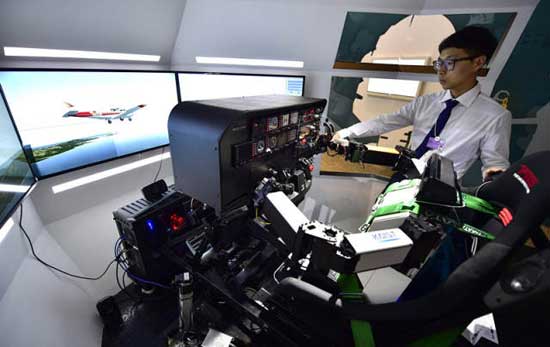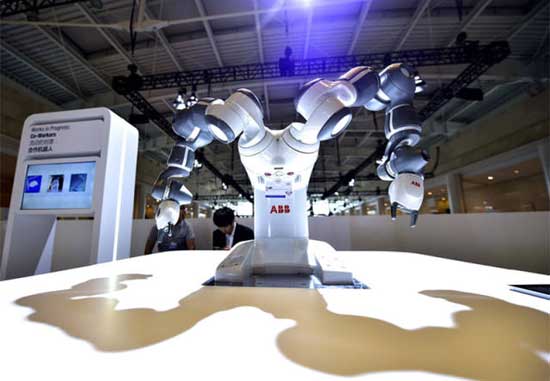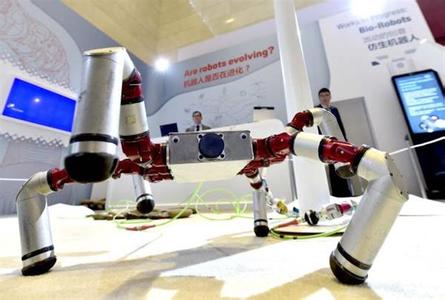

Is the fourth industrial revolution coming? Insiders have not yet reached consensus on this. Intelligent robots which will make debuts at the World Economic Forum in Tianjin, a port city of northern China have become stars and the 4.0 industry is expected to attract attention again worldwide.
Realistic robot Jia Jia

Jia Jia can talk and interact with real humans, as well as make some facial expressions. It was developed by a research team at the University of Science and Technology of China in Hefei, Anhui province.
Jia Jia has worked as a guide at school and in shopping malls, and also has a hostess in a TV show.
Humanoid robot Junko Chihira speaks three languages

Toshiba's humanoid robot Junko Chihira can speak three languages and works in a mall. She can exchange with consumers in accordance with the preset language and contents.
The developers say that Junko Chihira will learn to speak more languages and realize more man-machine communication in time. Its usage will be based in the health sector and will also be used as a companion.
Mybot is a humanoid robot with memory

Mybot is a humanoid robot capable of handling information, developed by the Korea Institute of Science and Technology. Mybot has memory, can identify the shapes of some objects and can learn to do housework.
Mybot is under development and will be used in the service sector in the future.
Pibot

Developed by the Korea Institute of Science and Technology, Pibot can fly. It will be used in high-risk work environments, such as during rescues after a disaster occurs.
YuMi -- a Robot for You and Me

Developed by ABB Engineering Shanghai, YuMi is short for “you and me,” which is meant to imply the robot was created to work well with humans. YuMi was designed to collaborate side-by-side, with human workers in a normal manufacturing environment. One of YuMi’s features is its “intrinsically safe” rating.
YuMi has been used as an assistant in the assembly of electronic products including smartphones and tablets.
SIX-LEGGED "SNAKE MONSTER"

Developed by Carnegie Mellon University, the robot Snake Monster with six legs looks more like an insect than a snake.
It can be used in exploration, disaster relief and medical care.
RoboBee

RoboBee is a tiny robot capable of tethered flight, developed by a robotics research team at Harvard University. To achieve flight, they created artificial muscles capable of beating the wings 120 times per second. The goal of the RoboBee project is to make a fully autonomous swarm of flying robots for applications such as search and rescue and artificial pollination. The 3-centimeter wingspan of the RoboBee makes it the smallest man-made device modeled on an insect to achieve flight.
Day|Week

 China's first intelligent security robot debuts in Chongqing
China's first intelligent security robot debuts in Chongqing A Total of 3,552 Subscribers Vanish In Two Days; YouTube Closes All Doors to Users’ Inquiries
A Total of 3,552 Subscribers Vanish In Two Days; YouTube Closes All Doors to Users’ Inquiries Out of this world! Futuristic UFO-shaped yacht has its own garden and a stunning underwater viewing deck
Out of this world! Futuristic UFO-shaped yacht has its own garden and a stunning underwater viewing deck An old tea house in Chengdu
An old tea house in Chengdu Furious Customer Crushes All the Buns from Vendor Just Because He Was Given the Wrong Flavor
Furious Customer Crushes All the Buns from Vendor Just Because He Was Given the Wrong Flavor 20 post-90s couples hold ’naked marriage‘ in E. China
20 post-90s couples hold ’naked marriage‘ in E. China Female official wearing traditional Han costume to promote local tourism
Female official wearing traditional Han costume to promote local tourism Over 12,000 Runners Seek Medical Care in S China’s Marathon
Over 12,000 Runners Seek Medical Care in S China’s Marathon Six Luxury Sports Cars Totaled after Fail Attempts to Cross China’s Most Perilous Highway Linking SW China’s Sichuan and Tibet
Six Luxury Sports Cars Totaled after Fail Attempts to Cross China’s Most Perilous Highway Linking SW China’s Sichuan and Tibet Incredible Transformation: “Witch Child”Whose Parents Left Him for Dead in Nigerian Makes Speedy Recovery
Incredible Transformation: “Witch Child”Whose Parents Left Him for Dead in Nigerian Makes Speedy Recovery